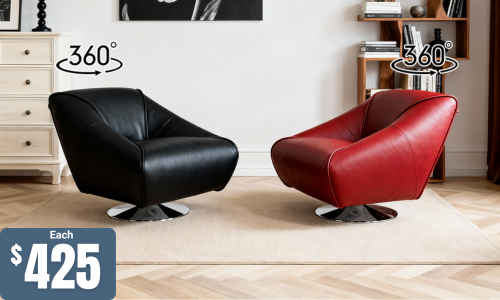Posts tagged with 'timeless aesthetics'
 In the realm of interior design, geometry serves as more than a mathematical concept; it emerges as a potent tool for creating visually arresting and organized living spaces. The prominence of geometric design in furniture has been steadily increasing, and its appeal is evident. With clean lines, precise angles, and harmonious patterns, geometric furniture effortlessly introduces structure and a modern aesthetic to your décor. In this article, we will delve into the allure of geometric design in furniture and explore how it can impart a sense of organisation to your living spaces.
In the realm of interior design, geometry serves as more than a mathematical concept; it emerges as a potent tool for creating visually arresting and organized living spaces. The prominence of geometric design in furniture has been steadily increasing, and its appeal is evident. With clean lines, precise angles, and harmonious patterns, geometric furniture effortlessly introduces structure and a modern aesthetic to your décor. In this article, we will delve into the allure of geometric design in furniture and explore how it can impart a sense of organisation to your living spaces.
Geometry in Furniture: A Time-Honoured Aesthetic:
The influence of geometry has pervaded furniture design for centuries, drawing inspiration from various architectural and design movements. From the iconic zigzags and chevrons of the Art Deco era to the clean lines of mid-century modernism, geometric patterns have etched their mark on the landscape of furniture design. Today, this design ethos is experiencing a revival, with geometric furniture taking centre stage in contemporary interior design.
Essential Elements of Geometric Furniture:
- Sleek Lines: Geometric furniture is characterised by its clean, straight lines. Whether it takes the form of a rectangular coffee table, a square bookshelf, or a triangular side table, these shapes contribute to the structured and orderly appearance of the furniture.
- Symmetry: Symmetrical patterns, such as repeated squares, circles, or hexagons, frequently feature prominently in geometric furniture. This symmetrical balance imbues the design with a sense of order and harmony.
- Contrast: Geometric furniture often relies on the interplay of contrasting elements, which may involve contrasting colours, materials, or shapes. These contrasts introduce visual interest and elevate geometric furniture pieces.
- Modularity: Many geometric furniture pieces are designed with modularity in mind. This means that you can rearrange or combine them to adapt to changing needs, enhancing the versatility of your décor.
Versatility of Geometric Furniture:
One of the most appealing aspects of geometric furniture is its versatility. It can seamlessly complement a wide range of interior design styles, from minimalistic and contemporary to industrial and retro. Here are some examples of how geometric furniture can enhance various living spaces:
- Living Room: Geometric coffee tables and shelving units can serve as captivating focal points, providing structure and functionality to your living area while offering a platform for showcasing your cherished décor items.
- Bedroom: A geometric bed frame or headboard can make a bold design statement, while geometric nightstands and dressers deliver storage solutions with a modern edge.
- Dining Area: Geometric dining tables and chairs can create an elegant, well-organised dining space, ideal for hosting guests.
- Home Office: Geometric desks and storage units not only offer a stylish workspace but also assist in maintaining an organised and clutter-free home office environment.
Pairing Geometric Furniture with Other Styles:
Geometric furniture can be seamlessly integrated with other design styles. For example, it can introduce structure and order to bohemian décor, introduce contrast in rustic settings, or enhance the sleekness of a contemporary space. Experiment with diverse combinations to strike the perfect balance that resonates with your personal style.
Geometric design in furniture transcends trends; it embodies a timeless aesthetic that infuses structure, equilibrium, and a contemporary allure into your décor. Whether you opt for a geometric coffee table as a statement piece or incorporate modular geometric shelving units for practical elegance, these pieces are poised to create a visual impact. Embrace the elegance of geometry in furniture design, and allow your décor to embody a sense of structure, harmony, and modern sophistication.
 Minimalism, with its focus on simplicity, functionality, and the "less is more" ethos, has left an indelible mark on contemporary furniture design. This influential design philosophy has significantly shaped the way we perceive and interact with furniture in our modern living spaces. In this article, we will delve into the profound impact of minimalism on contemporary furniture, tracing its origins and exploring its lasting relevance in the current design landscape.
Minimalism, with its focus on simplicity, functionality, and the "less is more" ethos, has left an indelible mark on contemporary furniture design. This influential design philosophy has significantly shaped the way we perceive and interact with furniture in our modern living spaces. In this article, we will delve into the profound impact of minimalism on contemporary furniture, tracing its origins and exploring its lasting relevance in the current design landscape.
Origins of Minimalism in Furniture Design
Minimalism as an art movement emerged in the mid-20th century, championed by artists and architects such as Mies van der Rohe, Le Corbusier, and Donald Judd. It sought to strip away excess, embracing the purity of form and function. This minimalist approach naturally found its way into furniture design, giving rise to iconic pieces that continue to enjoy popularity today.
Characteristics of Minimalist Contemporary Furniture
- Clean Lines: Minimalist furniture is characterised by clean, straight lines that exude simplicity and order. These lines contribute to a visually uncluttered and streamlined appearance.
- Functional Design: Minimalist furniture prioritises functionality. Each element serves a purpose, with unnecessary embellishments eliminated. This focus on practicality renders minimalist pieces versatile and timeless.
- Neutral Colour Palette: A neutral colour palette is a hallmark of minimalist design. Whites, blacks, grays, and earthy tones dominate, creating a tranquil and serene atmosphere. Occasionally, bold accent colours may be sparingly employed to add interest.
- Quality Materials: Minimalist furniture often features quality materials like natural wood, leather, steel, and glass. These materials not only ensure durability but also project an air of sophistication.
- Negative Space: The utilisation of negative space is pivotal in minimalist design. It allows the eye to rest and appreciate the simplicity of the furniture and the overall environment. This approach also contributes to a sense of openness and spaciousness.
Enduring Influence of Minimalism
The influence of minimalism on contemporary furniture design persists in several ways:
- Timeless Aesthetics: Minimalist furniture possesses a timeless quality that transcends trends. The clean lines and neutral colours make these pieces easy to incorporate into various interior design styles.
- Small-Space Living: As urban living spaces continue to shrink, minimalist furniture has become a practical choice. Its functional design and compact proportions make it ideal for small apartments and homes.
- Sustainability: Minimalism's emphasis on quality and functionality aligns with sustainability principles. Consumers increasingly seek furniture that is built to last, reducing the need for frequent replacements.
- Maximising Utility: Minimalist furniture's emphasis on functionality has led to innovative multi-purpose pieces. Sofa beds, storage beds, and extendable dining tables are examples of how minimalist design maximises utility.
- Minimalist Technology Integration: The rise of smart homes has seen the seamless integration of technology into minimalist furniture. Charging ports, built-in speakers, and other tech features blend effortlessly with minimalist aesthetics.
Minimalism has left an indelible imprint on contemporary furniture design, shaping its aesthetics, functionality, and sustainability. Today's designers continue to draw inspiration from the minimalist ethos, creating furniture that combines simplicity, versatility, and enduring appeal. Whether you reside in a compact living space, seek sustainable choices, or appreciate the beauty of clean lines and functionality, minimalism in contemporary furniture offers a compelling solution for modern living. Its influence remains as relevant and compelling as ever in the ever-evolving world of interior design.




.jpeg)

 (3).jpeg)
